The Deep South
Toward the end of July, Oya, Julia and I took a road trip from my parents' new house in Cleveland down to New Orleans. This is the trip to the Deep South I had been dreaming of for years, ever since I had my first short glimpse of the region when I passed through Memphis, way back in 2004.
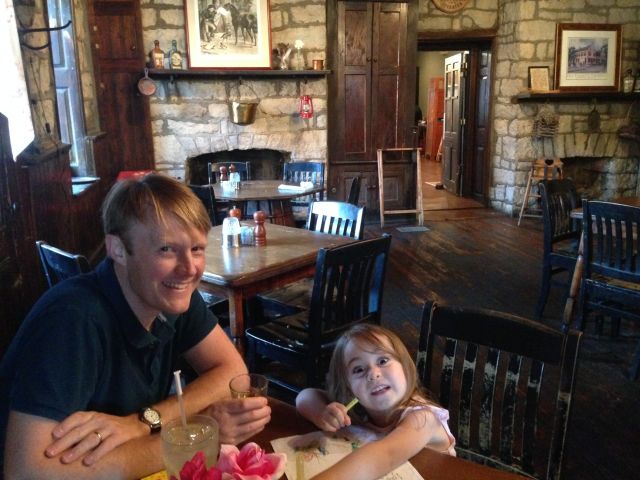
Our first day sent us southwest across Ohio and into Kentucky. I had driven through Kentucky when I moved from Indiana, and just as I was that first time, I was surprised by its beauty. Most of the state is rural and much of it seems to be farms raising thoroughbred horses plus the odd whisky distillery here and there. This time, though, the state seemed to me like an alternative version of England. Something about the foliage and the black painted fences and the genteel speech of an older man at Woodford Reserve whom I tasted bourbon with on the balcony. I could imagine early English settlers in the 1700's arriving and feeling at home, despite the temperatures being so far beyond what they would have been used to. We stayed in a pretty town called Bardstown which was once the very edge of the frontier. We would return to Bardstown at the end of the trip, and so I will return to my thoughts on the town a bit later on, as they helped me to put the whole journey into perspective.
In the morning, we stopped at Abraham Lincoln's birthplace and the monument to him which houses the famous log cabin. The fifty or so steps leading to a small building with massive columns is a bit like the approach to the Anit Kabir -- Ataturk's mausoleum in Ankara. And then, once inside, within a climate-controlled room, is the sacred cabin, completely divorced from the land on which it once stood. Or maybe once stood. My conversation with the guard brought out the following: the cabin may have been Abe Lincoln's birthplace, but only many years after the Lincolns lost their land was it claimed to be such. Then the cabin was taken around the country on display, disassembled and reassembled over and over again and at one point displayed next to the log cabin (also from Kentucky) where Jefferson Davis was born! When the cabin found its final resting place, it crowded the walking space too much, so rather than using the notches that had been used before, they pushed it in about a foot in every direction so that now the corners have these strange overhangs. It may as well have been Abe Lincoln's cabin, I told him. It is as close to a mythical object as we get in America.
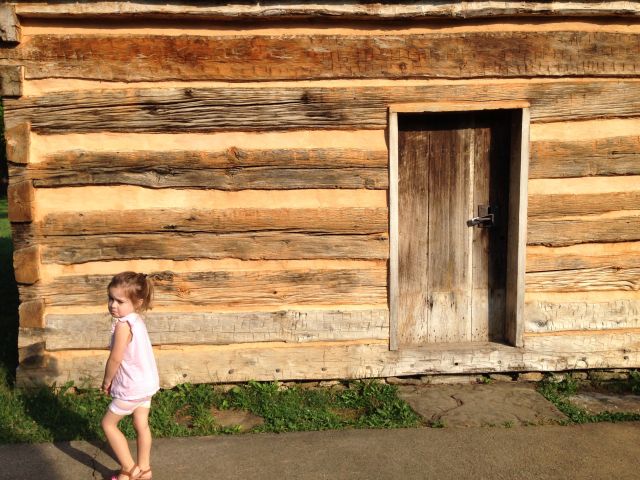
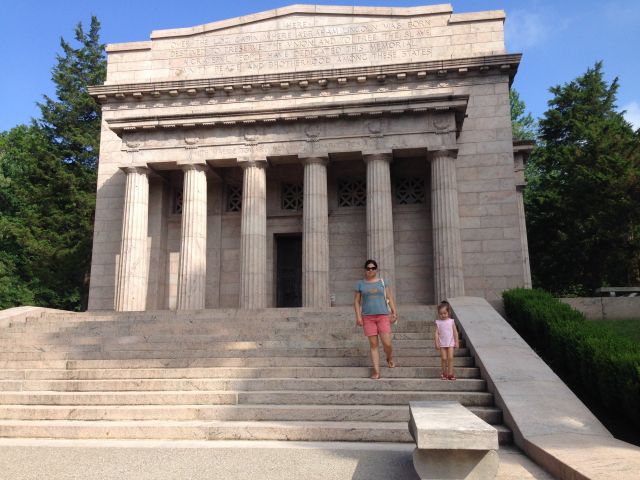
The drive through Tennessee was uneventful. The landscape grew more rugged: carved out limestone and forest lined the highway seemingly endlessly. And then at last, in the afternoon, we passed into Mississippi. This was new ground for all of us. As we entered the state and turned south, the foliage quickly changed to trees covered in something like ivy that created monstrous shapes around them. Later I found out it is called kudzu and is an invasive species imported from Japan to stop soil erosion but has now all but taken over. Those first miles of Mississippi before we got to Oxford were of special significance to me, as I knew this must be Faulkner's Yoknapatawpha County. The landscape was greener and less scrubby than I had expected, but the towns we passed through were as poor as I had anticipated. We were a couple of hours behind schedule, and there was one place that I had to see in Oxford before it closed that evening, and that was Rowan Oak. Faulkner's house is right at the edge of the city but feels like it is in the middle of the woods once you have come far enough down the drive from the main road. The property is ringed by massive cedars, and the approach to the house is lined in these same cedars. Julia had fallen asleep in the car, and so she and Oya remained behind for a few minutes while I high-tailed it to the house. I came through the door with my copy of Absalom, Absalom! and Oya's of As I Lay Dying (in Turkish) under my arm, hoping there would be some kind of stamp like the one you get at Shakespeare & Company. There wasn't, but I was given a pair of very nice bookmarks made from cedarwood, with the image of a typewriter branded on them. The house is large but doesn't take much time to walk through. The kitchen looked like it hadn't changed since the 1940's, and in the hallway that lead to it was Faulkner's "phone book" where he had scratched numbers of everyone he knew on the wall above the telephone. Upstairs I spent a long time looking through the doorway of Faulkner's bedroom, trying to make out the titles of the books that were still on the shelf beside his bed. There was a collection of artifacts belonging to him in a glass cabinet in the upstairs hallway, including some empty bottles of the Four Roses bourbon that I had tried in Bardstown. This is the American literary mecca, and the visit, as brief as it was, had the aura of a religious experience. When I came back downstairs, I found Oya and Julia in the entryway. There were only a few minutes left before the doors closed for the day, and with my head still in a state of wonder, a man and his son (Southerners to boot!) walked through the front door and asked in all earnestness, "Could you tell us who William Faulkner was?" Other than the cedar walkway, the other most notable thing about the grounds is the circular garden: a series of concentric circles of stone set in the ground that has now sunk so deep into the dirt that it appears as a series of ridges that may as well be as ancient at Machu Picchu. I took some sound recordings which have the distinct sound of birds after a rain on a humid day. After settling into our place in Oxford, we ventured into town on foot. The center of town is a square built around the courthouse. All of the buildings have large balconies on their second stories. It was a Wednesday night, but everyone seemed to be out. We had a great Southern meal with catfish, collard greens, butter beans, sweet potatoes and all the rest. There was lightning in the air but no rain. We had an ice cream and then walked home.
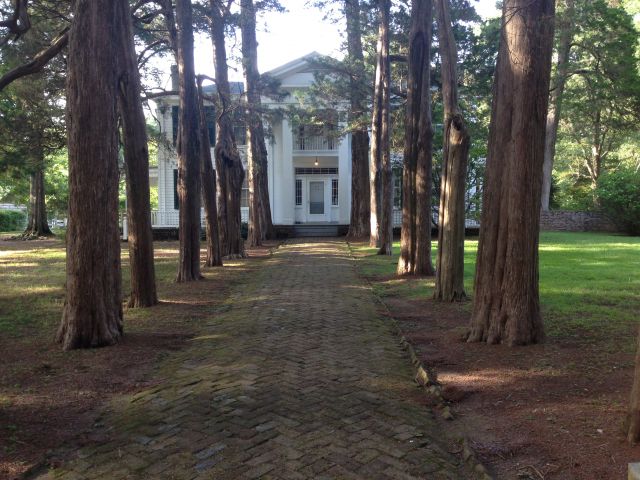
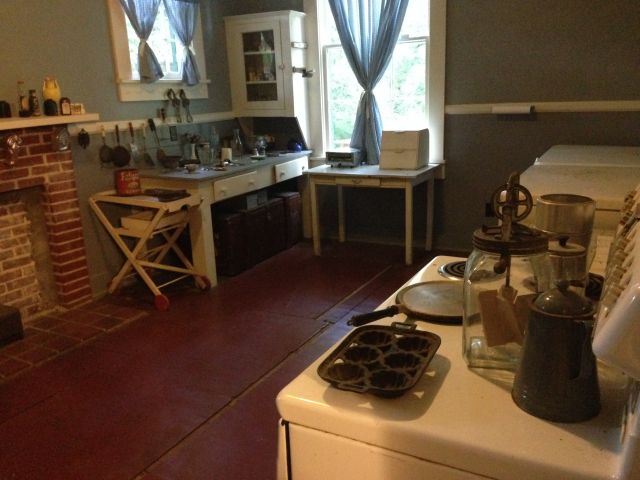
Our drive the next day took us to Jackson and then southeast down the leafy Natchez Trace Parkway, which must be one of the most beautiful roads in America. We had to stop two or three times when it rained so hard that I couldn't see out of the windshield. The road ends right at Natchez, where we would stay the following night. I didn't know much about the town of Natchez before we got there except that it was one of the oldest settlements along the southern Mississippi River. We stayed in a B&B in an old mansion on a street of mansions that had once belonged to Jewish carpetbaggers who arrived after the Civil War. Comparing these mansions -- which were not small by any means -- with the antebellum mansion I would see the next day put some perspective on the meaning and scope of wealth. We took a walk on a bluff above the water to a restaurant down near the landing where the steamboats used to come in (and where the steamboat tours still come in). Looking down and across the Mississippi at Natchez, Langston Hughes' description seemed apt: I've seen its muddy bosom turn all golden in the sunset. Our host had promised us he would screen Buster Keaton's The General when we got home that evening, but he never came down to the living room, and so we went to bed. In the morning, we took a tour of Stanton Hall, one of the most magnificent of the old plantation homes. All of the plantations in Natchez were located across the river in Louisiana, so the mansions are not on huge grounds but merely sit here and there in the town of Natchez.
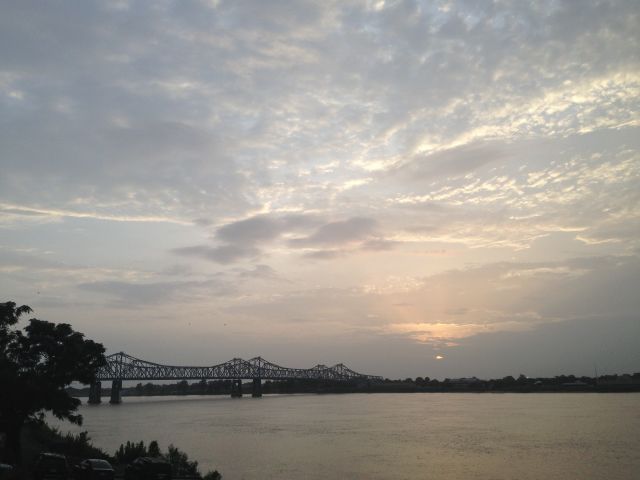
From Natchez it is just two or three hours' drive to New Orleans. This was our final destination and the one I had been curious about for a decade-and-a-half. As soon as we crossed the border of Louisiana, Julia was on the lookout for alligators. The highway on the way into the city follows a narrow slip of land on one side of Lake Pontchartrain. Most of the time there doesn't seem to be any land at all, just swamp and then occasionally a train track that sits just above the water. The train into Venice has a similar feeling, as though in leaving the mainland you have left the world you have taken for granted for another world you could not have conceived of, but here it is wilder, more exotic. We passed through Metairie, where my great aunt lived, and then came to a shotgun house on Oak Street, on the eastern edge of New Orleans.
A few years ago, I planted the seed that lead my friend Joseph DeFalco to move to New Orleans. Seeing him was one of the reasons for our trip, and so the next three days he was, to some extent, our guide. That first evening, after eating hot dogs topped with crawfish etouffee, we found ourselves at a place called The Columns on St. Charles Avenue. Just as the name implies, there is a porch with a massive set of white columns where we sat, in a space hemmed in by live oaks. We talked over mint juleps. The whole moment was so complete, so perfect.
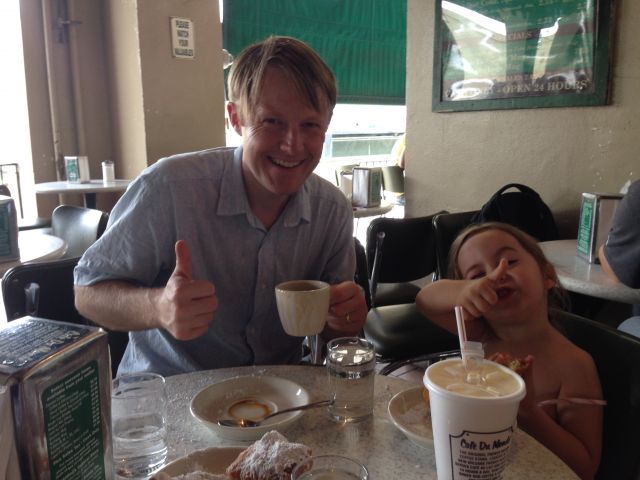
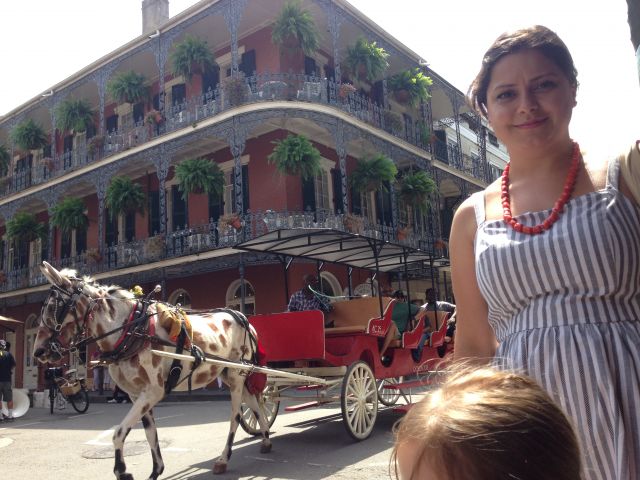
The streetcar that makes its way up and down St. Charles Avenue all day was one of my highlights of the trip. It is the world's oldest streetcar line and is up there with the streetcars in Lisbon, vying for my absolute favorite. St. Charles Avenue felt like the main artery of New Orleans and was the road we drove most to get from one side of the city to the other. On either side it is lined with mansions, and I believe the street is unique in America to have such fine homes so close to a piece of public transportation where the rich of so many other American cities would hide away in quieter streets, and I wondered if that said something about the nature of the city. The next morning we rode the streetcar to the French Quarter and got beignets and coffee at Cafe du Monde. This is one of those sweets like the pasteis de nata in Belem, Lisbon that is so tied to the place that it couldn't possibly be as good elsewhere -- the humidity wouldn't right or the coffee cups would be the wrong shape. It was so hot that day that whenever we tried to walk anywhere, we had to duck into an air-conditioned shop to cool off. We had a good lunch and cold daiqiris in the French Market before heading off to the little museum of Voodoo. The French Quarter is a real beauty whichever direction you look -- the delicate wrought-iron balconies, the wooden houses. Around 5:00, Joseph and his friend Keely met us for an evening walking tour of the Quarter, which was lead by a modern-day pirate. While we were waiting for the tour to begin, Joseph bought two hurricanes next door and handed me one. As we stood on the street corner sipping our drinks, he asked, "Has it sunk in yet?" And that is one of the things that makes New Orleans different from any American city I have been to. People walk around drinking cocktails on the street all day. They're probably drinking to-go cocktails while they drive their cars for all I know. I never went to a drive-through liquor store, but I know they exist.
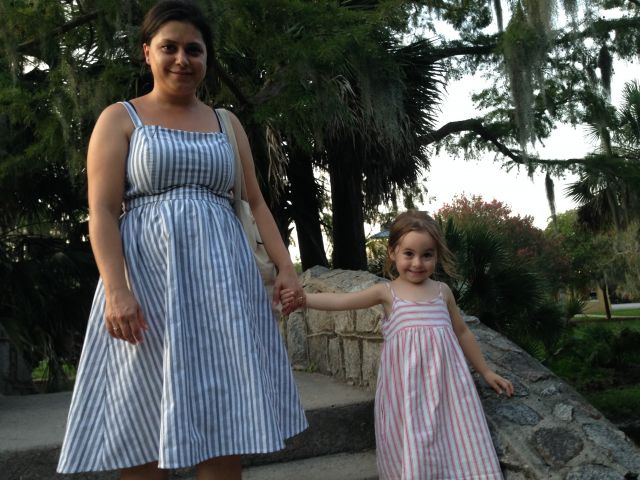
New Orleans is full of great parks. We visited Audubon Park by night and City Park by evening. I didn't see alligators in either, but both have a feeling of otherworldliness I cannot begin to explain. The wonder of New Orleans, really, is in a European culture (French, in this case) coming to a place of such drastically different climate and then adapting to it -- but this time the results are more startling, more unexpected than, say, Englishmen in Kentucky. There are European fountains in Audubon Park surrounded by live oaks draped in dry moss that, by night, hint at a mystery deep, startling, inexplicable. It is a mystery unique to the New World, where foreign cultures have grafted themselves upon landscapes incongruous with them but then taken root and grown.
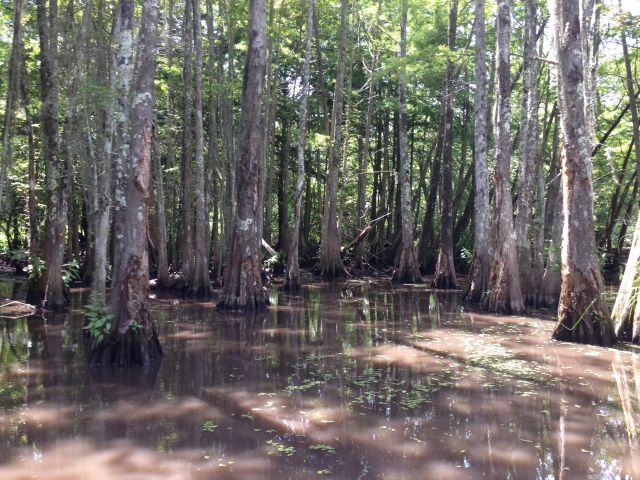
Our final full day, along with Joseph and Keely, we drove across Lake Pontchartrain to the Honey Island cypress swamp for a boat tour. Our main aim was to see alligators, but everything about the swamp was fascinating. First, there was the natural aspect. We saw herons, raccoons and a number of juvenile alligators. The cypress trees growing out of the water were their own fascination. For anyone who hasn't been to a swamp, off of the main waterways, there are smaller waterways that go deeper into the swamp, where most of the wildlife is found. Then there was the human aspect -- the shacks built along the main waterway, many in states of dilapidation. Every time an alligator approached our boat, the captain lured it closer with hot dog or a marshmallow on a stick. I was pretty sure this wasn't ecologically responsible, but we were able to see some of the alligators up close. Finally we ran into the biggest alligator I could imagine. The captain said he was about twelve feet long and was maybe 30 years old. He had seen him out in the swamp most of his life but often didn't see him for months at a time. He no longer had any teeth but had the largest set of jaws I have ever seen. He snapped them a few times for us before swimming off into the swamp.
When we left Louisiana, I lamented that during my time in the Pelican State, I never saw a pelican. We drove up Highway 61 through the Mississippi Delta toward Memphis. Just on the outskirts of Clarksdale I found one of those spots that looms in American mythology as heavily as the locations associated with Greek myths scattered across the Mediterranean: the crossroads of Highways 49 and 61 where Robert Johnson is said to have sold his soul to the devil to become the greatest blues guitarist of all time. Clarksdale itself is a sad town. We were there on a Sunday, and the old blues joints I was hoping to visit were all closed. Late in the evening, we arrived in Memphis.

I had fond memories of Memphis from the couple of days I spent there in 2004, but now it also struck me as sad. It has been such an important location in American history so many times, which makes its run-down nature puzzling. Without even looking for it, I came across the Lorraine Motel where MLK was shot, which is now the site of the Civil Rights Museum. We stayed right next door to Graceland, but I had been there before, and Oya didn't want to spend half-a-day there, so we skipped it. We did visit Sun Records, where Elvis made his first recordings. It was Oya's birthday, and when she told the tour guide, he told us to stick around after the tour had ended. After everyone had left the recording room, he took us back into the sound room, where all of the control panels seemed to be from the 50's.
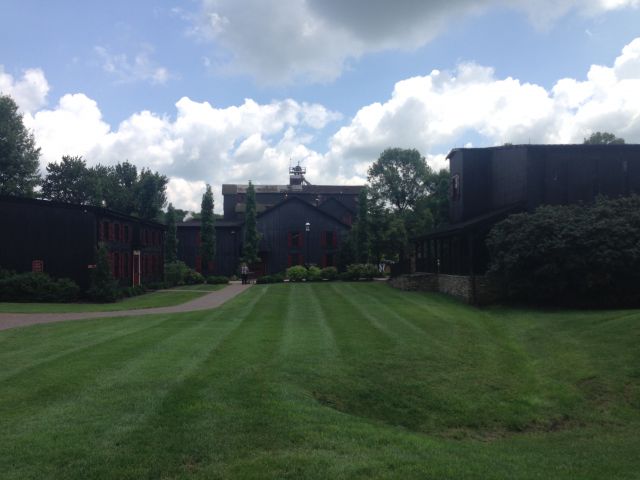
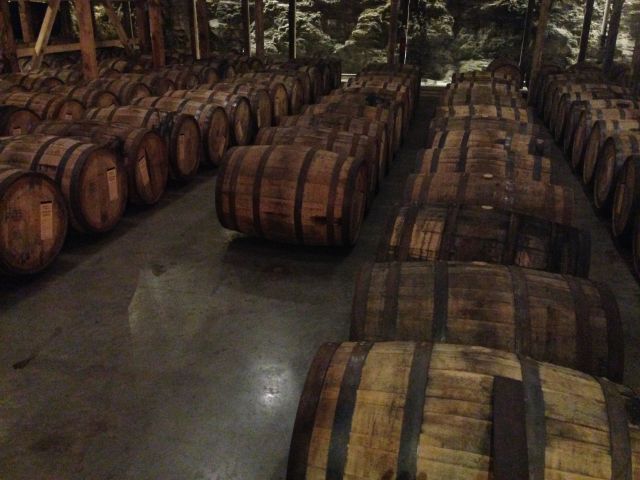
The final night of our trip was spent in Bardstown, Kentucky, where we had begun a week before. We ate at the Old Talbott Tavern, where we had eaten before. There are few things about this place worth noting that in some way round out my whole experience of the South. The Talbott Inn houses the oldest bourbon bar in America. Daniel Boone once came here. So did Washington Irving and Abe Lincoln. George Washington sent the exiled King of France, Louis-Philippe to Bardstown when he wished to see the frontier, and there is a mural in an upstairs bedroom at the inn painted by him... and then shot full of holes by Jesse James. And that is one more thing about the South that I couldn't get past -- this is where American history transpired, in a way that it never transpired in the West. We started our drive home with stops at Heaven Hill and a longer one at Maker's Mark to see them make their whisky and get one last, lingering taste of the South.

Our first day sent us southwest across Ohio and into Kentucky. I had driven through Kentucky when I moved from Indiana, and just as I was that first time, I was surprised by its beauty. Most of the state is rural and much of it seems to be farms raising thoroughbred horses plus the odd whisky distillery here and there. This time, though, the state seemed to me like an alternative version of England. Something about the foliage and the black painted fences and the genteel speech of an older man at Woodford Reserve whom I tasted bourbon with on the balcony. I could imagine early English settlers in the 1700's arriving and feeling at home, despite the temperatures being so far beyond what they would have been used to. We stayed in a pretty town called Bardstown which was once the very edge of the frontier. We would return to Bardstown at the end of the trip, and so I will return to my thoughts on the town a bit later on, as they helped me to put the whole journey into perspective.
In the morning, we stopped at Abraham Lincoln's birthplace and the monument to him which houses the famous log cabin. The fifty or so steps leading to a small building with massive columns is a bit like the approach to the Anit Kabir -- Ataturk's mausoleum in Ankara. And then, once inside, within a climate-controlled room, is the sacred cabin, completely divorced from the land on which it once stood. Or maybe once stood. My conversation with the guard brought out the following: the cabin may have been Abe Lincoln's birthplace, but only many years after the Lincolns lost their land was it claimed to be such. Then the cabin was taken around the country on display, disassembled and reassembled over and over again and at one point displayed next to the log cabin (also from Kentucky) where Jefferson Davis was born! When the cabin found its final resting place, it crowded the walking space too much, so rather than using the notches that had been used before, they pushed it in about a foot in every direction so that now the corners have these strange overhangs. It may as well have been Abe Lincoln's cabin, I told him. It is as close to a mythical object as we get in America.


The drive through Tennessee was uneventful. The landscape grew more rugged: carved out limestone and forest lined the highway seemingly endlessly. And then at last, in the afternoon, we passed into Mississippi. This was new ground for all of us. As we entered the state and turned south, the foliage quickly changed to trees covered in something like ivy that created monstrous shapes around them. Later I found out it is called kudzu and is an invasive species imported from Japan to stop soil erosion but has now all but taken over. Those first miles of Mississippi before we got to Oxford were of special significance to me, as I knew this must be Faulkner's Yoknapatawpha County. The landscape was greener and less scrubby than I had expected, but the towns we passed through were as poor as I had anticipated. We were a couple of hours behind schedule, and there was one place that I had to see in Oxford before it closed that evening, and that was Rowan Oak. Faulkner's house is right at the edge of the city but feels like it is in the middle of the woods once you have come far enough down the drive from the main road. The property is ringed by massive cedars, and the approach to the house is lined in these same cedars. Julia had fallen asleep in the car, and so she and Oya remained behind for a few minutes while I high-tailed it to the house. I came through the door with my copy of Absalom, Absalom! and Oya's of As I Lay Dying (in Turkish) under my arm, hoping there would be some kind of stamp like the one you get at Shakespeare & Company. There wasn't, but I was given a pair of very nice bookmarks made from cedarwood, with the image of a typewriter branded on them. The house is large but doesn't take much time to walk through. The kitchen looked like it hadn't changed since the 1940's, and in the hallway that lead to it was Faulkner's "phone book" where he had scratched numbers of everyone he knew on the wall above the telephone. Upstairs I spent a long time looking through the doorway of Faulkner's bedroom, trying to make out the titles of the books that were still on the shelf beside his bed. There was a collection of artifacts belonging to him in a glass cabinet in the upstairs hallway, including some empty bottles of the Four Roses bourbon that I had tried in Bardstown. This is the American literary mecca, and the visit, as brief as it was, had the aura of a religious experience. When I came back downstairs, I found Oya and Julia in the entryway. There were only a few minutes left before the doors closed for the day, and with my head still in a state of wonder, a man and his son (Southerners to boot!) walked through the front door and asked in all earnestness, "Could you tell us who William Faulkner was?" Other than the cedar walkway, the other most notable thing about the grounds is the circular garden: a series of concentric circles of stone set in the ground that has now sunk so deep into the dirt that it appears as a series of ridges that may as well be as ancient at Machu Picchu. I took some sound recordings which have the distinct sound of birds after a rain on a humid day. After settling into our place in Oxford, we ventured into town on foot. The center of town is a square built around the courthouse. All of the buildings have large balconies on their second stories. It was a Wednesday night, but everyone seemed to be out. We had a great Southern meal with catfish, collard greens, butter beans, sweet potatoes and all the rest. There was lightning in the air but no rain. We had an ice cream and then walked home.


Our drive the next day took us to Jackson and then southeast down the leafy Natchez Trace Parkway, which must be one of the most beautiful roads in America. We had to stop two or three times when it rained so hard that I couldn't see out of the windshield. The road ends right at Natchez, where we would stay the following night. I didn't know much about the town of Natchez before we got there except that it was one of the oldest settlements along the southern Mississippi River. We stayed in a B&B in an old mansion on a street of mansions that had once belonged to Jewish carpetbaggers who arrived after the Civil War. Comparing these mansions -- which were not small by any means -- with the antebellum mansion I would see the next day put some perspective on the meaning and scope of wealth. We took a walk on a bluff above the water to a restaurant down near the landing where the steamboats used to come in (and where the steamboat tours still come in). Looking down and across the Mississippi at Natchez, Langston Hughes' description seemed apt: I've seen its muddy bosom turn all golden in the sunset. Our host had promised us he would screen Buster Keaton's The General when we got home that evening, but he never came down to the living room, and so we went to bed. In the morning, we took a tour of Stanton Hall, one of the most magnificent of the old plantation homes. All of the plantations in Natchez were located across the river in Louisiana, so the mansions are not on huge grounds but merely sit here and there in the town of Natchez.

From Natchez it is just two or three hours' drive to New Orleans. This was our final destination and the one I had been curious about for a decade-and-a-half. As soon as we crossed the border of Louisiana, Julia was on the lookout for alligators. The highway on the way into the city follows a narrow slip of land on one side of Lake Pontchartrain. Most of the time there doesn't seem to be any land at all, just swamp and then occasionally a train track that sits just above the water. The train into Venice has a similar feeling, as though in leaving the mainland you have left the world you have taken for granted for another world you could not have conceived of, but here it is wilder, more exotic. We passed through Metairie, where my great aunt lived, and then came to a shotgun house on Oak Street, on the eastern edge of New Orleans.
A few years ago, I planted the seed that lead my friend Joseph DeFalco to move to New Orleans. Seeing him was one of the reasons for our trip, and so the next three days he was, to some extent, our guide. That first evening, after eating hot dogs topped with crawfish etouffee, we found ourselves at a place called The Columns on St. Charles Avenue. Just as the name implies, there is a porch with a massive set of white columns where we sat, in a space hemmed in by live oaks. We talked over mint juleps. The whole moment was so complete, so perfect.


The streetcar that makes its way up and down St. Charles Avenue all day was one of my highlights of the trip. It is the world's oldest streetcar line and is up there with the streetcars in Lisbon, vying for my absolute favorite. St. Charles Avenue felt like the main artery of New Orleans and was the road we drove most to get from one side of the city to the other. On either side it is lined with mansions, and I believe the street is unique in America to have such fine homes so close to a piece of public transportation where the rich of so many other American cities would hide away in quieter streets, and I wondered if that said something about the nature of the city. The next morning we rode the streetcar to the French Quarter and got beignets and coffee at Cafe du Monde. This is one of those sweets like the pasteis de nata in Belem, Lisbon that is so tied to the place that it couldn't possibly be as good elsewhere -- the humidity wouldn't right or the coffee cups would be the wrong shape. It was so hot that day that whenever we tried to walk anywhere, we had to duck into an air-conditioned shop to cool off. We had a good lunch and cold daiqiris in the French Market before heading off to the little museum of Voodoo. The French Quarter is a real beauty whichever direction you look -- the delicate wrought-iron balconies, the wooden houses. Around 5:00, Joseph and his friend Keely met us for an evening walking tour of the Quarter, which was lead by a modern-day pirate. While we were waiting for the tour to begin, Joseph bought two hurricanes next door and handed me one. As we stood on the street corner sipping our drinks, he asked, "Has it sunk in yet?" And that is one of the things that makes New Orleans different from any American city I have been to. People walk around drinking cocktails on the street all day. They're probably drinking to-go cocktails while they drive their cars for all I know. I never went to a drive-through liquor store, but I know they exist.

New Orleans is full of great parks. We visited Audubon Park by night and City Park by evening. I didn't see alligators in either, but both have a feeling of otherworldliness I cannot begin to explain. The wonder of New Orleans, really, is in a European culture (French, in this case) coming to a place of such drastically different climate and then adapting to it -- but this time the results are more startling, more unexpected than, say, Englishmen in Kentucky. There are European fountains in Audubon Park surrounded by live oaks draped in dry moss that, by night, hint at a mystery deep, startling, inexplicable. It is a mystery unique to the New World, where foreign cultures have grafted themselves upon landscapes incongruous with them but then taken root and grown.

Our final full day, along with Joseph and Keely, we drove across Lake Pontchartrain to the Honey Island cypress swamp for a boat tour. Our main aim was to see alligators, but everything about the swamp was fascinating. First, there was the natural aspect. We saw herons, raccoons and a number of juvenile alligators. The cypress trees growing out of the water were their own fascination. For anyone who hasn't been to a swamp, off of the main waterways, there are smaller waterways that go deeper into the swamp, where most of the wildlife is found. Then there was the human aspect -- the shacks built along the main waterway, many in states of dilapidation. Every time an alligator approached our boat, the captain lured it closer with hot dog or a marshmallow on a stick. I was pretty sure this wasn't ecologically responsible, but we were able to see some of the alligators up close. Finally we ran into the biggest alligator I could imagine. The captain said he was about twelve feet long and was maybe 30 years old. He had seen him out in the swamp most of his life but often didn't see him for months at a time. He no longer had any teeth but had the largest set of jaws I have ever seen. He snapped them a few times for us before swimming off into the swamp.
When we left Louisiana, I lamented that during my time in the Pelican State, I never saw a pelican. We drove up Highway 61 through the Mississippi Delta toward Memphis. Just on the outskirts of Clarksdale I found one of those spots that looms in American mythology as heavily as the locations associated with Greek myths scattered across the Mediterranean: the crossroads of Highways 49 and 61 where Robert Johnson is said to have sold his soul to the devil to become the greatest blues guitarist of all time. Clarksdale itself is a sad town. We were there on a Sunday, and the old blues joints I was hoping to visit were all closed. Late in the evening, we arrived in Memphis.

I had fond memories of Memphis from the couple of days I spent there in 2004, but now it also struck me as sad. It has been such an important location in American history so many times, which makes its run-down nature puzzling. Without even looking for it, I came across the Lorraine Motel where MLK was shot, which is now the site of the Civil Rights Museum. We stayed right next door to Graceland, but I had been there before, and Oya didn't want to spend half-a-day there, so we skipped it. We did visit Sun Records, where Elvis made his first recordings. It was Oya's birthday, and when she told the tour guide, he told us to stick around after the tour had ended. After everyone had left the recording room, he took us back into the sound room, where all of the control panels seemed to be from the 50's.


The final night of our trip was spent in Bardstown, Kentucky, where we had begun a week before. We ate at the Old Talbott Tavern, where we had eaten before. There are few things about this place worth noting that in some way round out my whole experience of the South. The Talbott Inn houses the oldest bourbon bar in America. Daniel Boone once came here. So did Washington Irving and Abe Lincoln. George Washington sent the exiled King of France, Louis-Philippe to Bardstown when he wished to see the frontier, and there is a mural in an upstairs bedroom at the inn painted by him... and then shot full of holes by Jesse James. And that is one more thing about the South that I couldn't get past -- this is where American history transpired, in a way that it never transpired in the West. We started our drive home with stops at Heaven Hill and a longer one at Maker's Mark to see them make their whisky and get one last, lingering taste of the South.
Don't miss what's next. Subscribe to Ned Entrikin's Travels: